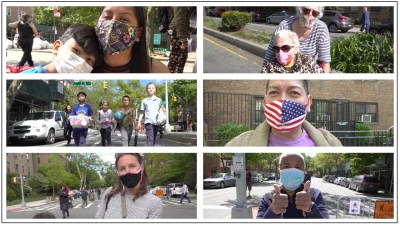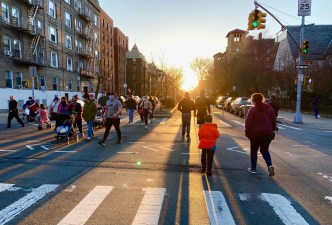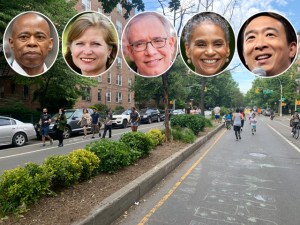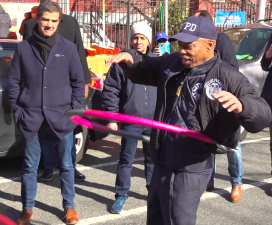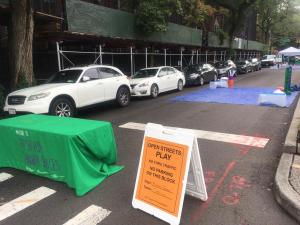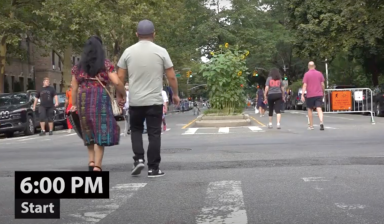SQUARE ONE: De Blasio Punts ‘Gold Standard’ Open Street Implementation to Next Mayor

Mayor de Blasio has decided to leave final design and implementation of the permanent 34th Avenue open street — which his own Department of Transportation calls “the gold standard” — to the next mayor, a move that stunned both supporters of a linear park proposal and opponents of the effort to retain the health and safety that the neighborhood’s open street has provided over the last year.
The bombshell was dropped during Wednesday night’s Community Board 3 Traffic and Transportation Committee meeting, at which DOT was expected to reveal a vision for the corridor between Junction Boulevard and 69th Street — one that followed the City Council’s legislation making the open streets program permanent and requiring DOT to “evaluate open streets to determine whether to apply further design changes, such as a conversion to a shared street or pedestrian plaza.”
For weeks, DOT officials said they would come to CB3 with a plan in June — the fruit of months of “visioning sessions” and surveys that were described by Jason Banrey, DOT Deputy Borough Commissioner for Queens, as historic in scope. He said he has met with the community board seven times about the project, in addition to meeting with local schools, retirement communities, elected officials, the open street volunteer group, the main opposition group to the open street, the Jackson Heights Beautification Group, the Jackson Heights Green Alliance, partner agencies within city government, plus conducting an online survey. The process of reimagining the dangerous and polluted roadway started back to winter, 2018, but began anew with the COVID-19 pandemic and the need to bring open space to a neighborhood with among the least amount of it.
Yet somehow, opponents of the open street — who claim they seek a “compromise,” but actually want to reduce or eliminate the open street entirely — have convinced the DOT that their voices have not yet been heard, and that the process, mandated by city law, must be slowed down [PDF of the presentation].
“A lot of people have been asking us to slow this down and we are honoring that,” Banrey said during a 90-minute virtual meeting on Wednesday night when many voices were, in fact, heard. He added that there will be changes on 34th Avenue, thanks to the demand for a linear park from virtually every elected, but he also said the resulting vision will be “a compromise.”
The definition of that word is very much subject to debate in a greenspace-starved neighborhood where drivers have access to every single roadway and supporters of a linear park are asking for one roadway in the neighborhood to be free of the danger, pollution and congestion that is endemic to a culture and streetscape shaped by and for the car.
Update @Art4MayorNYC and @AndrewYang say they have signed the petition, too. Interested? https://t.co/WAMImVg53L
— Streetsblog New York (@StreetsblogNYC) June 10, 2021
Officially, Banrey offered this retarded timeline:
- Summer, 2021: The city will work on “operational improvements” to ease the work of volunteers, who are moving barricades every morning and night. It is unclear what that means, though there will be money to assist the volunteer effort.
- Fall, 2021: The DOT team will “design” its “interim” plan for 34th Avenue.
- Fall/winter, 2021: The DOT says it will present that “interim” plan to the community board, elected officials and the public — a process that has been ongoing for months and was expected to be unveiled in June. The “fall/winter” timeline means that no design will be presented before Sept. 21, and could be released as late as Dec. 21 — nine days before the mayor leaves office.
- Spring, 2022: “Implement interim improvements.” This part of the timeline would leave the next mayor in charge of carrying out whatever remaining vision the current mayor has.
That altered and delayed timeline is not merely significant to Jackson Heights and Corona residents, but to all people watching how the de Blasio administration will create a permanent open streets program, since 34th Avenue was seen as the leading edge of the DOT’s efforts, now stalled.
For now, the agency said it would continue seeking “feedback” from Jackson Heights residents and that it would be “looking for ways to build on the successes of the open street.”
Passed by this group of people, educators and kids out on 34th Ave #openstreet exploring ways to use space to teach children. Hooray!!!@MarkGortonNYC @lisaorman3 @NYC_DOT @StreetsblogNYC @NYCMayor @NYCSpeakerCoJo pic.twitter.com/6gfw86kAdm
— Streetfilms (Now 1,100 films strong!) (@Streetfilms) June 11, 2021
Successes are many: Banrey also said that the open street — which bars thru-traffic and requires drivers to limit their speeds to five miles per hour — has made 34th Avenue safer than ever before. Streetsblog asked DOT to explain how the roadway got so safe, with crashes down 80 percent during the open street hours, and the agency went far further than Banrey was willing to go before the hostile crowd at CB3:
“Both the safety and public space benefits we’ve seen over the last year are in part due to slow vehicular speeds and low vehicular volumes, so any treatments we’re looking at aim to build on that feeling of a local street,” agency spokesman Brian Zumhagen said.
Such facts are not accepted by the opponents of the safer, healthier, calmer, quieter roadway.
“Saftey [sic] is important and 34th is not safe,” an open street opponent Scott Brevda posted in the chat. He later complained about speeding bicyclists and motor scooter operators — though speeding scooter operators, speeding cars and speeding trucks are an issue on all roadways (Banrey promised to ask the 115th Precinct for beat cops to ticket anyone violating the fiv-mile-per-hour rule, though that would also apply to car drivers, too.)
Leaving the implementation of the permanent open street to the next mayor could be good news for the supporters of the linear park, as more and more candidates rush to sign on to that group’s petition. Since Kathryn Garcia signed last month, Andrew Yang and Art Chang have also joined the campaign, and Scott Stringer has pledged to sign. In addition to those candidates specifically calling for a linear park, Eric Adams, Maya Wiley and Dianne Morales have all signed onto the Transportation Alternatives’ “25X25” plan, which calls for repurposing 25 percent of automobile space such as parking as public space for people not cars.
Parking is one of the main “concerns” that opponents of open space, health and safety raised in the chat of the virtual community board meeting on Wednesday night.

“Please STOP taking our parking,” posted Gloria Contreras, a leader of the so-called “34th Compromise” group that seeks to eliminate or dramatically reduce the hours or length of the existing open street (point of fact: only a few parking spaces hav been eliminated for bike parking along the avenue). “Street parking is difficult enough.” (Officially, DOT claims it is not seeking to remove parking: “Regarding parking removal, none is proposed at this time, as we have not yet presented a proposal.]
If Contreras wants to do something about the parking “problem,” she could address her neighbors’ continued insistence on purchasing cars and expecting to store them for free on public streets. According to the Census, the median income of a car-free households in the neighborhood is $42,761, or roughly $25,000 less than the neighborhood’s median income.
Households that own one car have a median income roughly 60 percent higher, or $68,214. And households with two cars have median incomes that are 170 percent higher than the non-car owners, or $115,140.
Census data also show that between 2010 and 2018, 680 more households got a car in Jackson Heights, and the number of households that have three or more cars increased by 229. So there’s a lot more cars in the neighborhood, which leads to more road fatalities and more pollution, which is killing us all slowly, a new Harvard study reminded this week.
Banrey did not reveal any specifics about the now-late 2021 proposal, but he did prepare the community board — which has been skeptical at best — that the open street is far more popular than the tiny group of opponents filling the meeting chat room would have anyone believe. Of the 853 postings in the chat, 565 were made by just 15 opponents of the open street, an indication that the so-called “compromise” of reducing or eliminating the open street are not the majority they think they are.
Indeed, according to a DOT online survey of area residents from the winter, 77 percent of people support “permanent changes to make 34th Avenue a pedestrian and cycling priority corridor.”
But Banrey and Cronstein gave conflicting signals throughout, an indication that the agency simply does not know what it or its boss wants to do.
“We will maintain pedestrian and cyclist prioritization, but also vehicular access. People still need to park,” Cronstein said, sort of, but not entirely, dashing linear park supporters’ hopes (even the linear park supporters’ petition calls for vehicular access to the dozen or so garages on the strip).
But later she added that the DOT is still considering a “plaza block” configuration that would “break up the through traffic so 34th Avenue doesn’t end up as a highway.”
Sidebar: What does Curtis Sliwa think?
Just for fun, we asked Republican mayoral candidate Curtis Sliwa what he think should happen on 34th Avenue. Here is his unedited, Larry King-esque response:
Can we do something first about the map grid in this part of Queens? Every time I am there, which is often, I get geographical vertigo. You have 34th Avenue, 34th Street, 34th Road…the only thing they are missing is 34th Place. 34th Avenue runs parallel to Northern Blvd which is overcrowded to begin with so now we want to close this whole stretch to almost all kinds of vehicular traffic.
My experience with Open Streets was to stand last summer on Sixth Avenue in Sunset Park on a Saturday afternoon between 44th Street and 51st Street and for a full hour there was no activity whatsoever.
When I was a child the Police Athletic League would shut a street down and it was called a Play Street. We played stickball, punch ball, volleyball, basketball and other street games with supervision. That provided good utilization of a closed street.
The proposal of closing down 34th Avenue seems to be well motivated but misguided as to how this can work and satisfy the neighborhood’s needs. It does strike me as another attack to limit residential vehicular use in an area that is not well serviced by mass transit. [Point of fact: Jackson Heights is served by the 7, E, F, M and R trains, plus the Long Island Rail Road and more than a dozen bus lines.]
My policy is the same as it is toward bike lanes; if you don’t use it, you lose it and if you use it, we keep it.
And who monitors this to make sure the rules are followed? If there is a violation, who do you call? 911, the Police, I’m sure they don’t want the police there. Or 311, traffic enforcement, I’m sure they don’t want them there in their police uniforms. And what are the consequences for the rule breakers? And what plan is there for the traffic overflow in surrounding streets as a result of closing this large section of 34th Avenue? And because there is a divider straight through 34th Avenue which side is useable for vehicles and which side is not? I’m open to discussion and having my concerns addressed.
